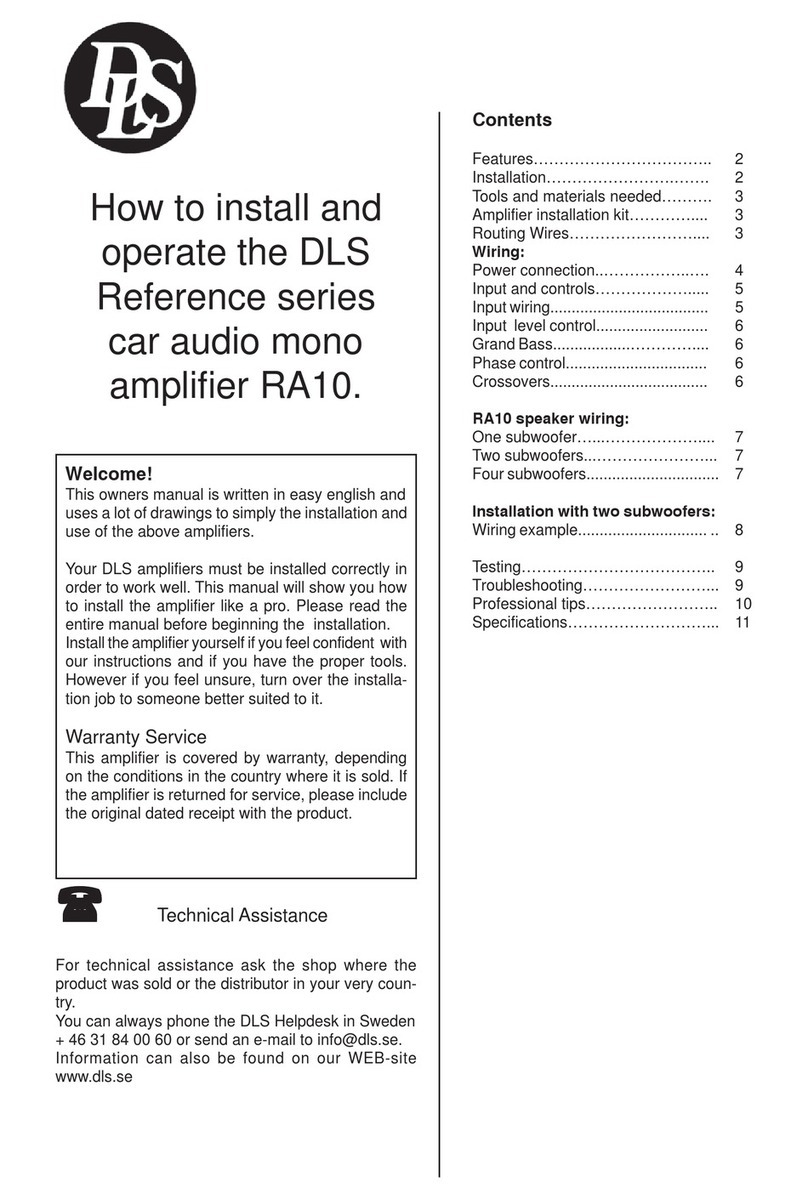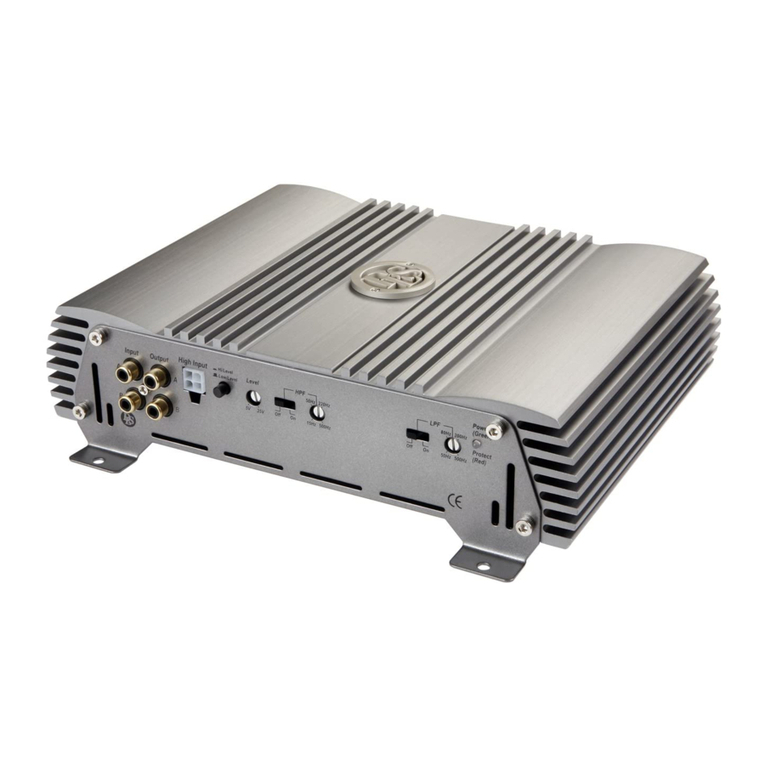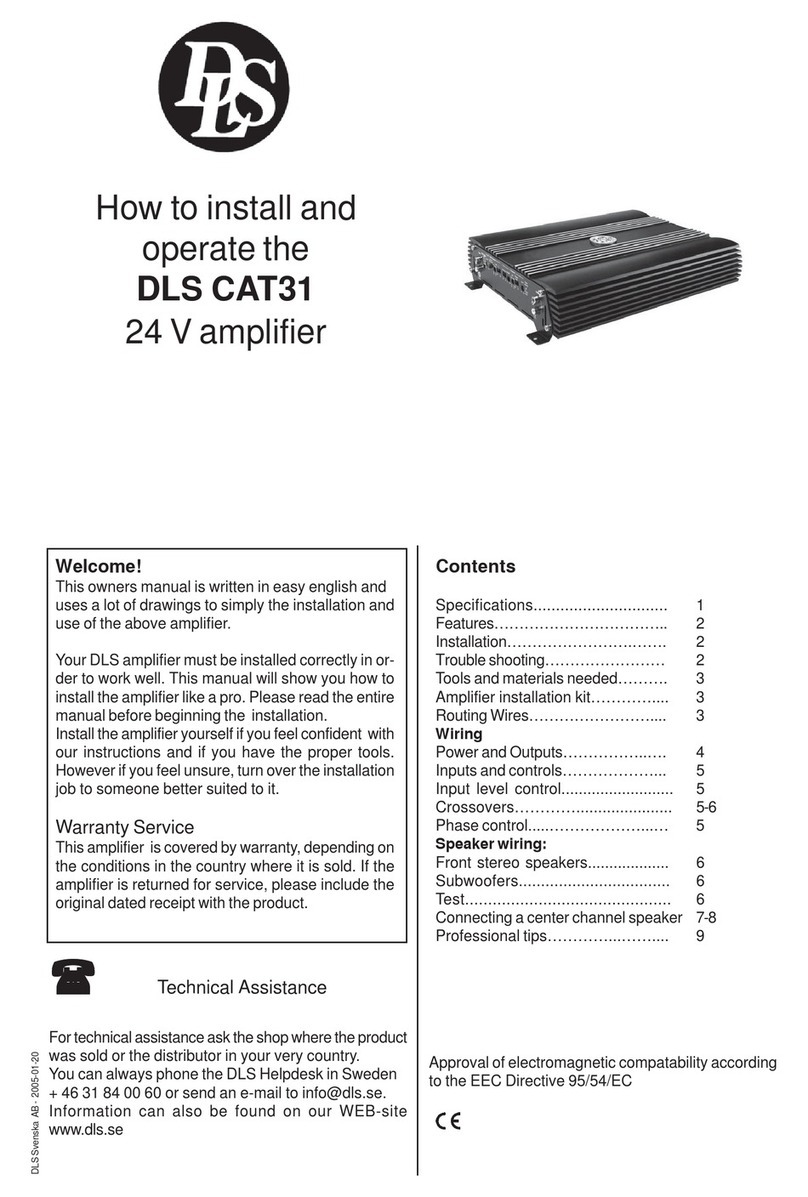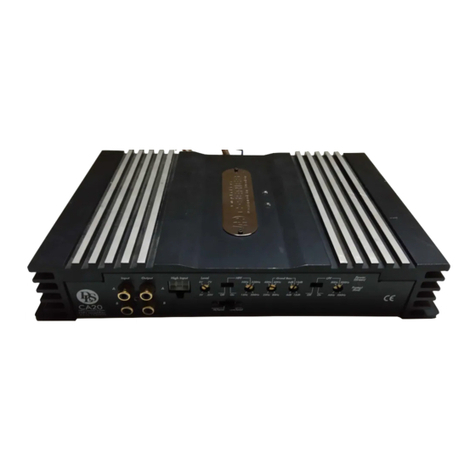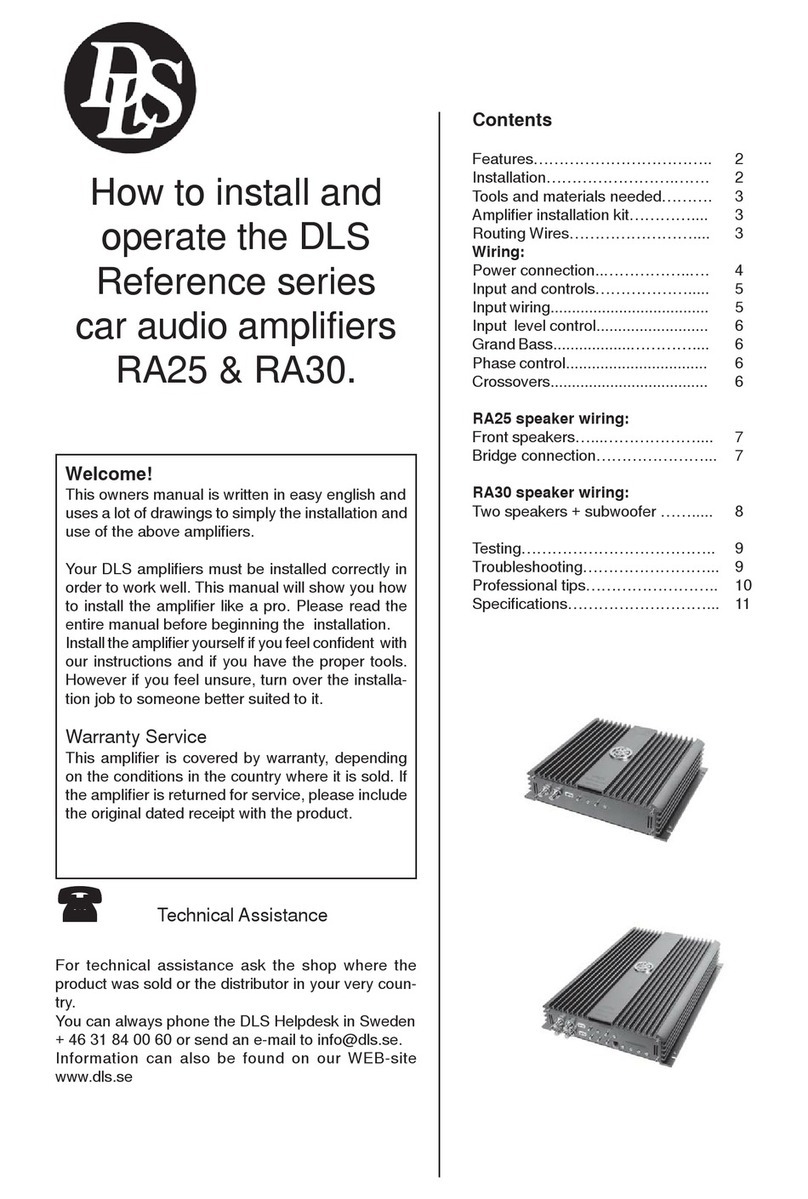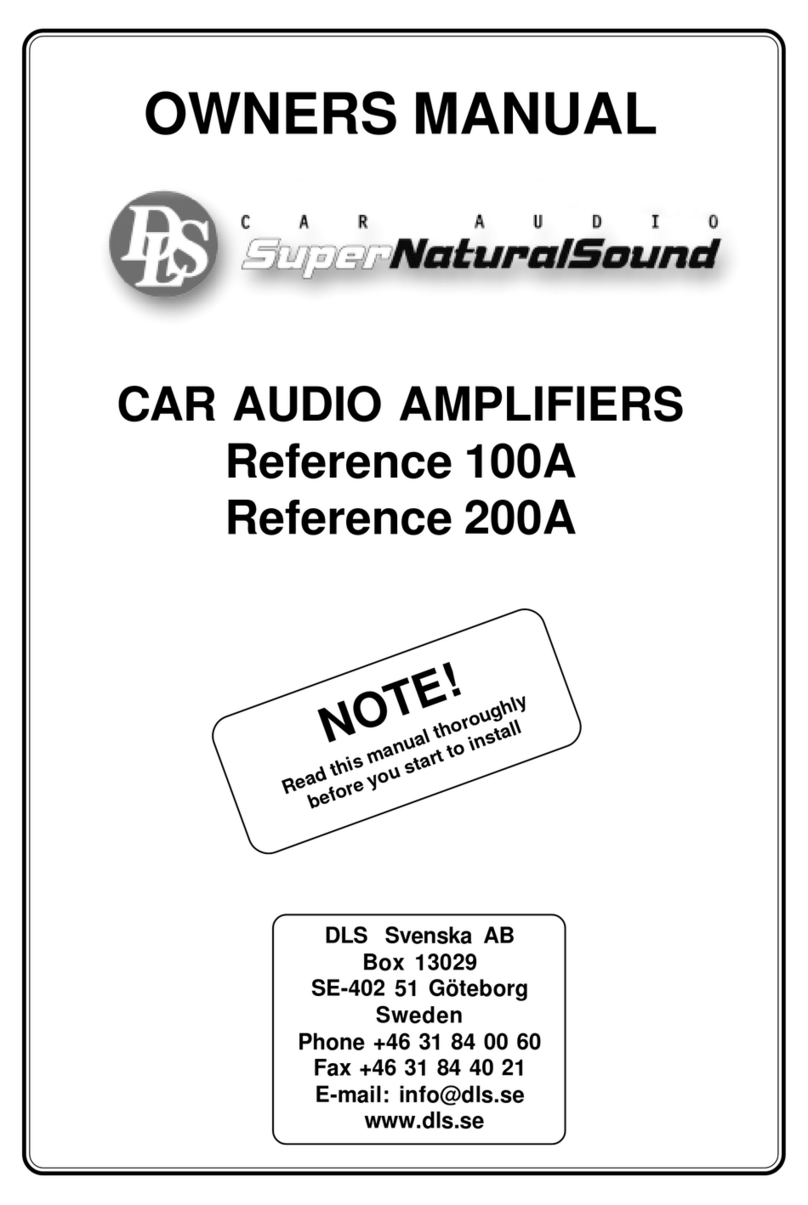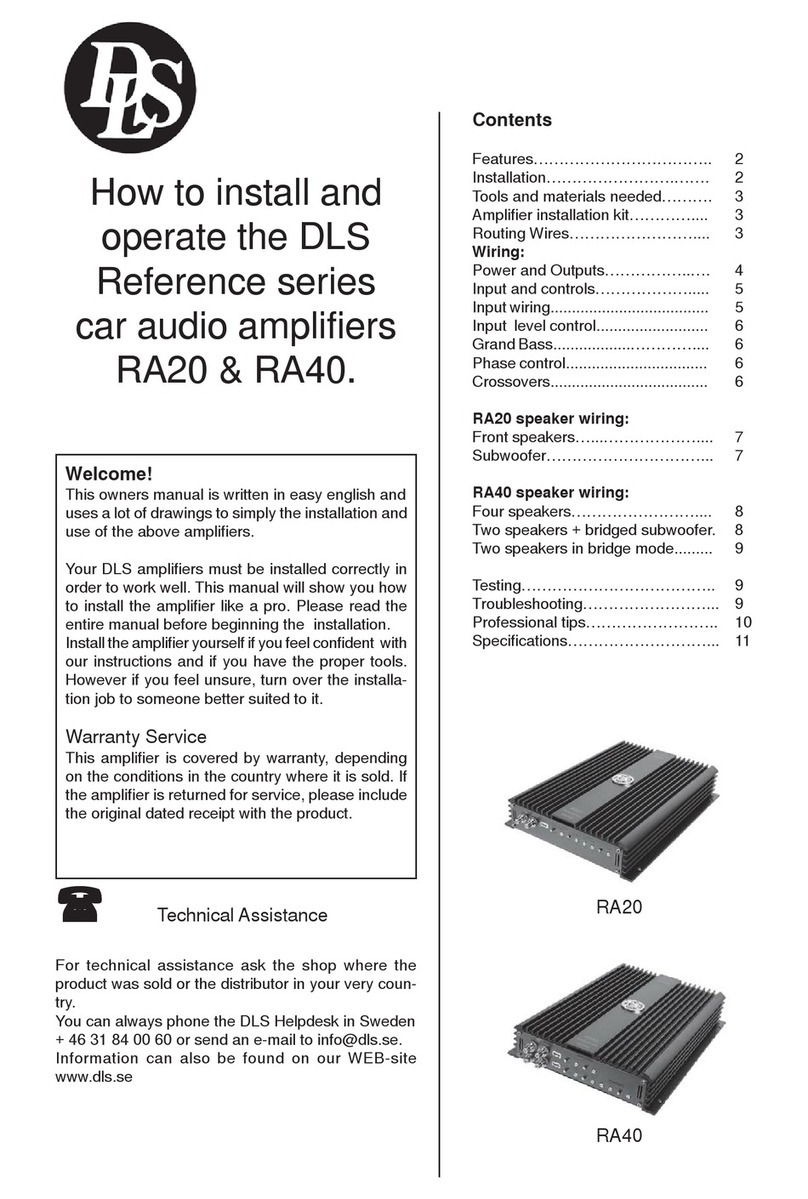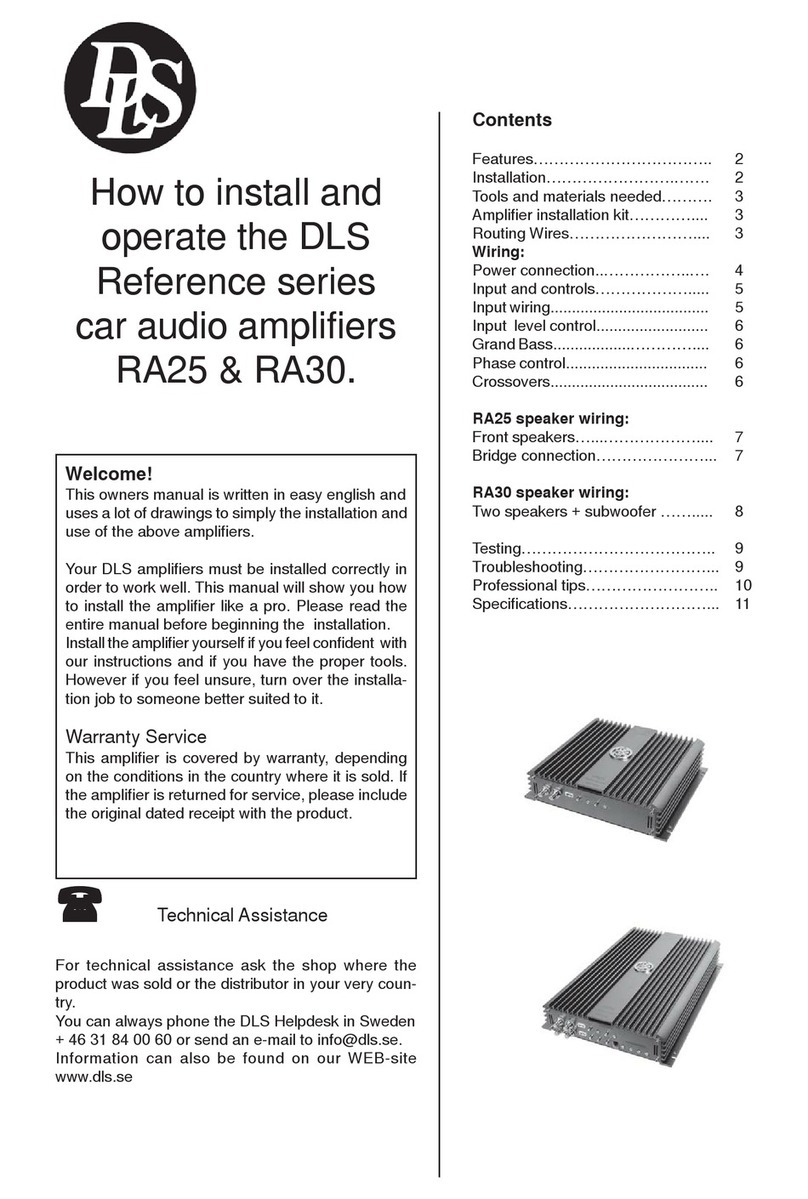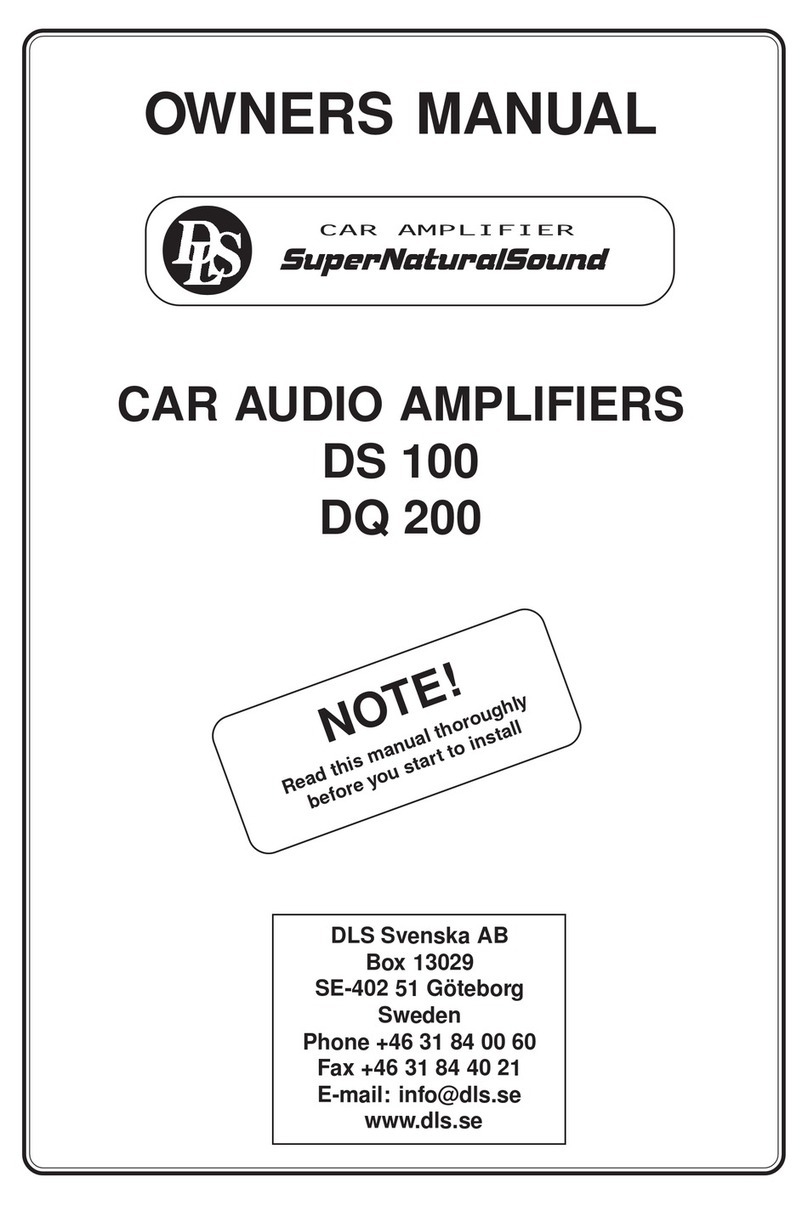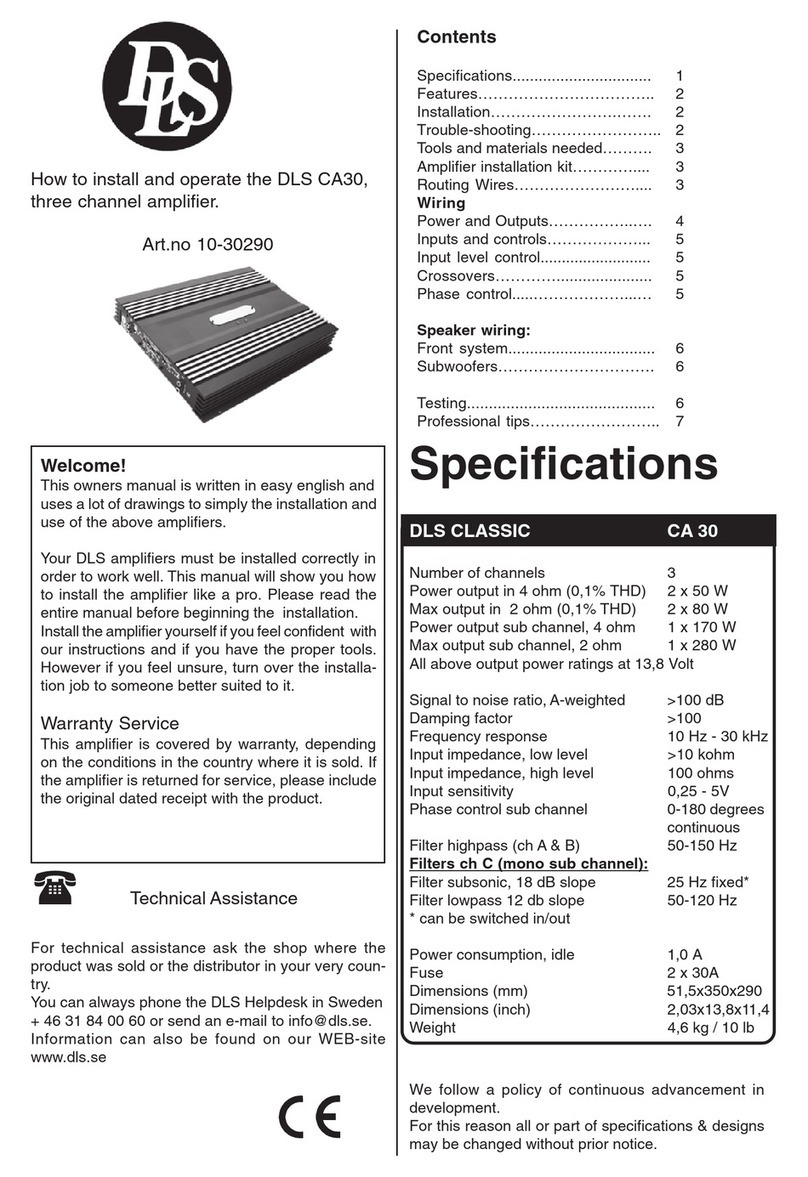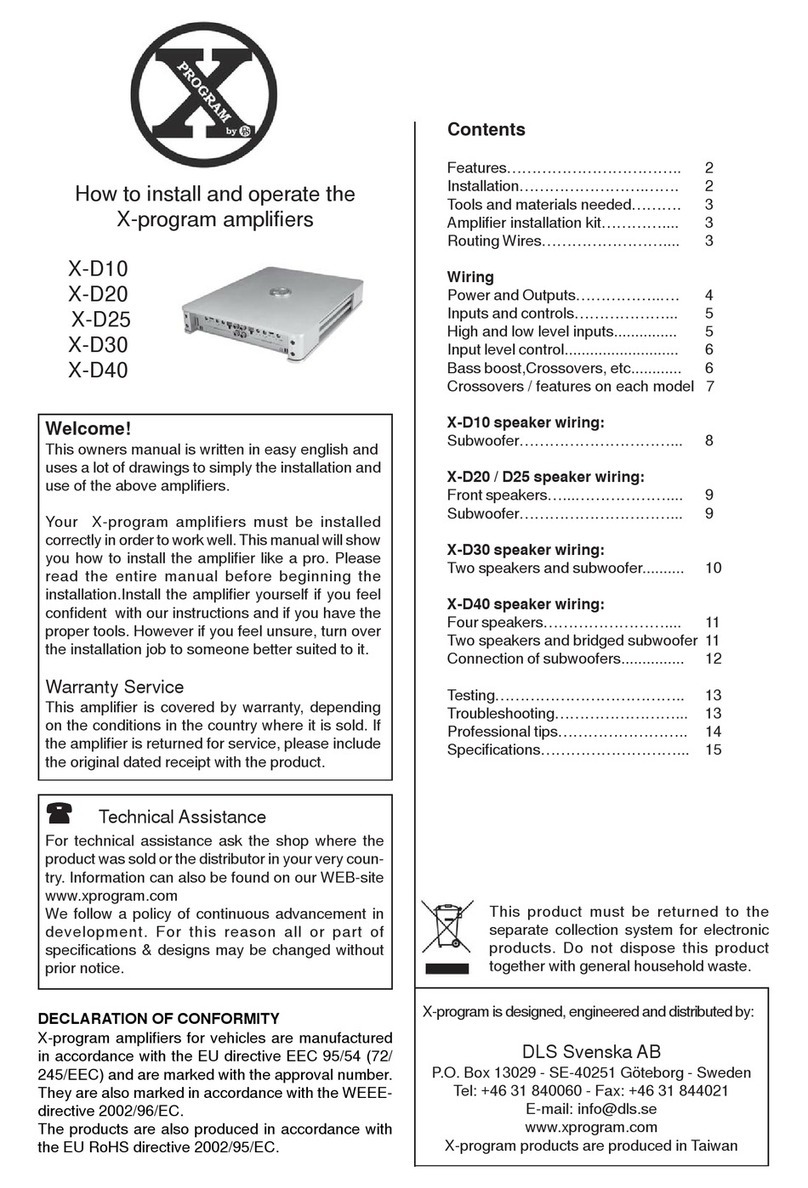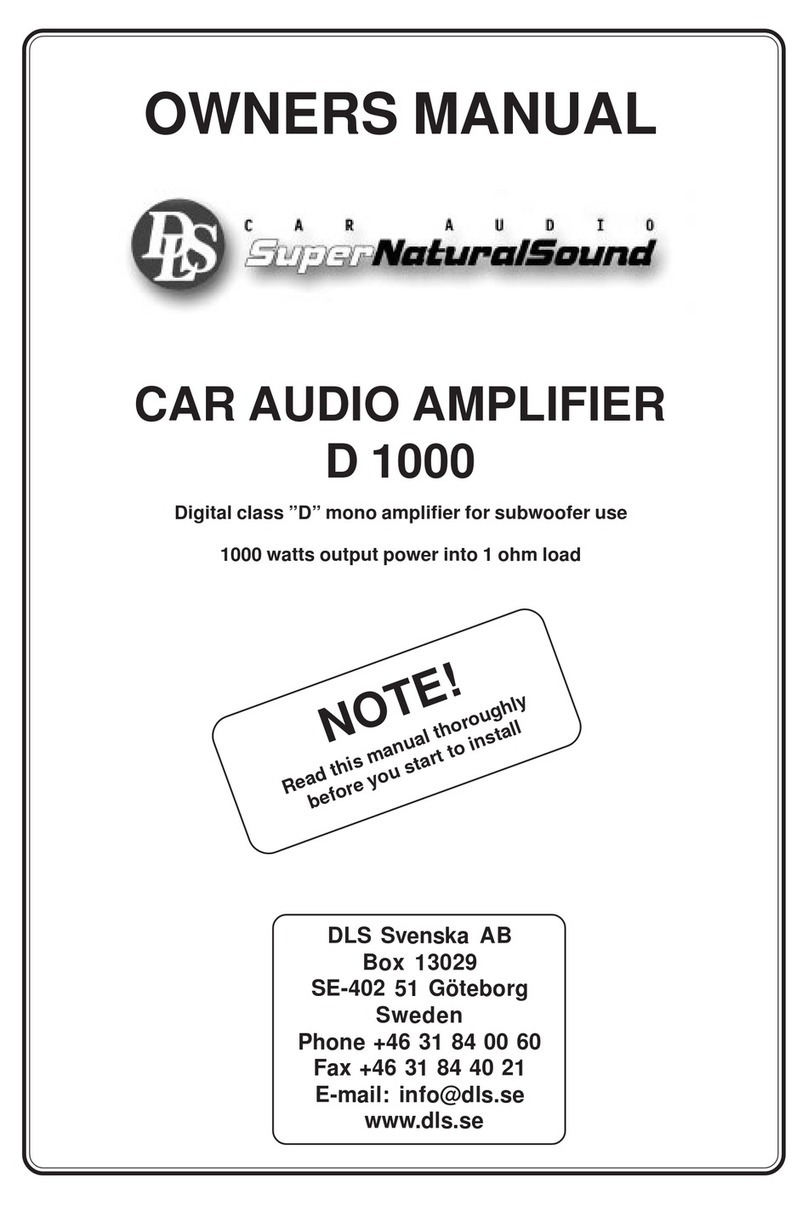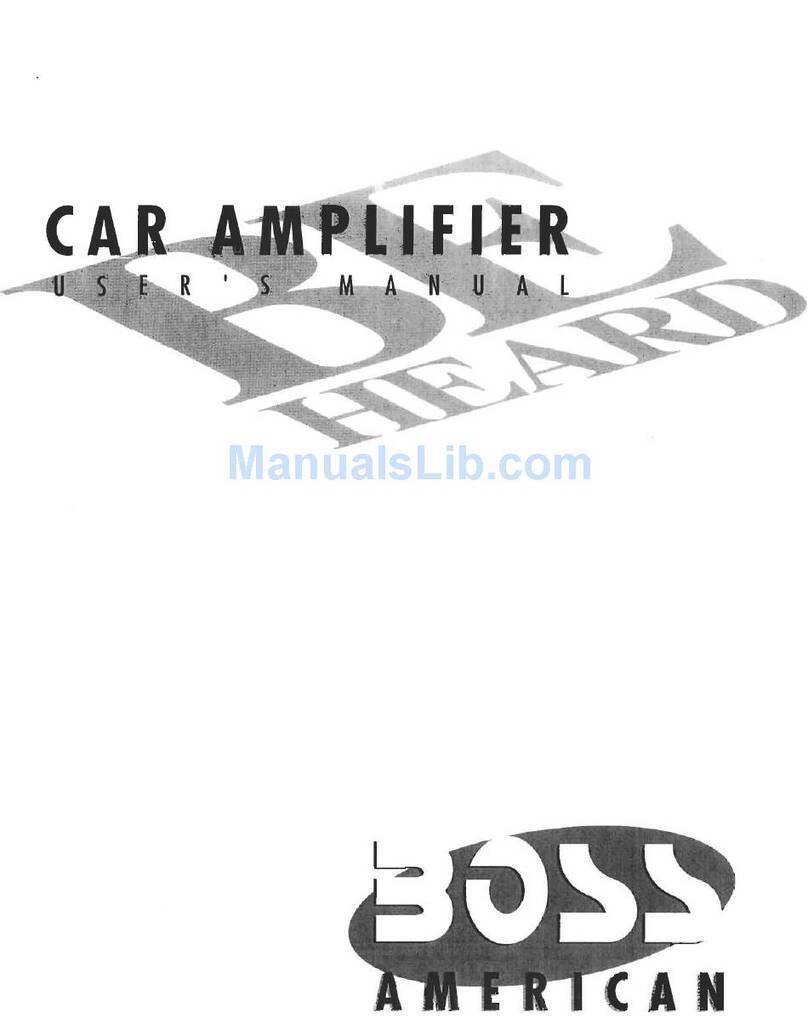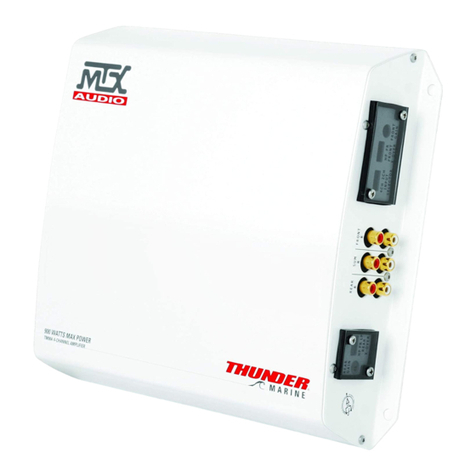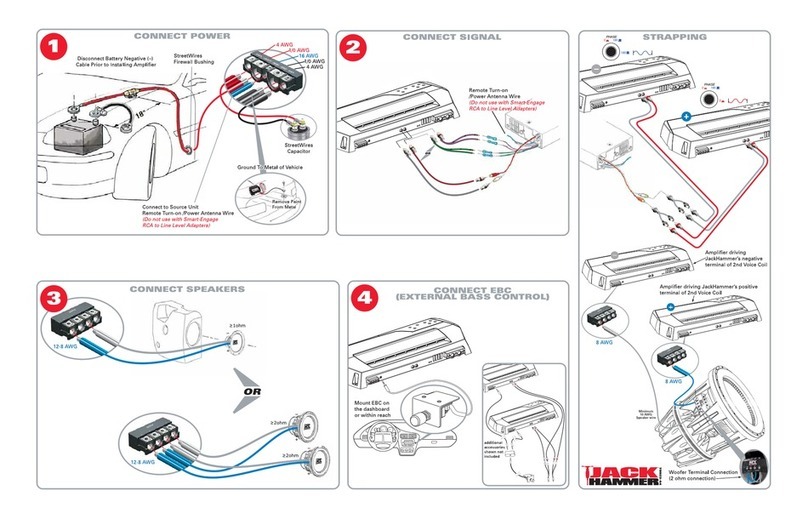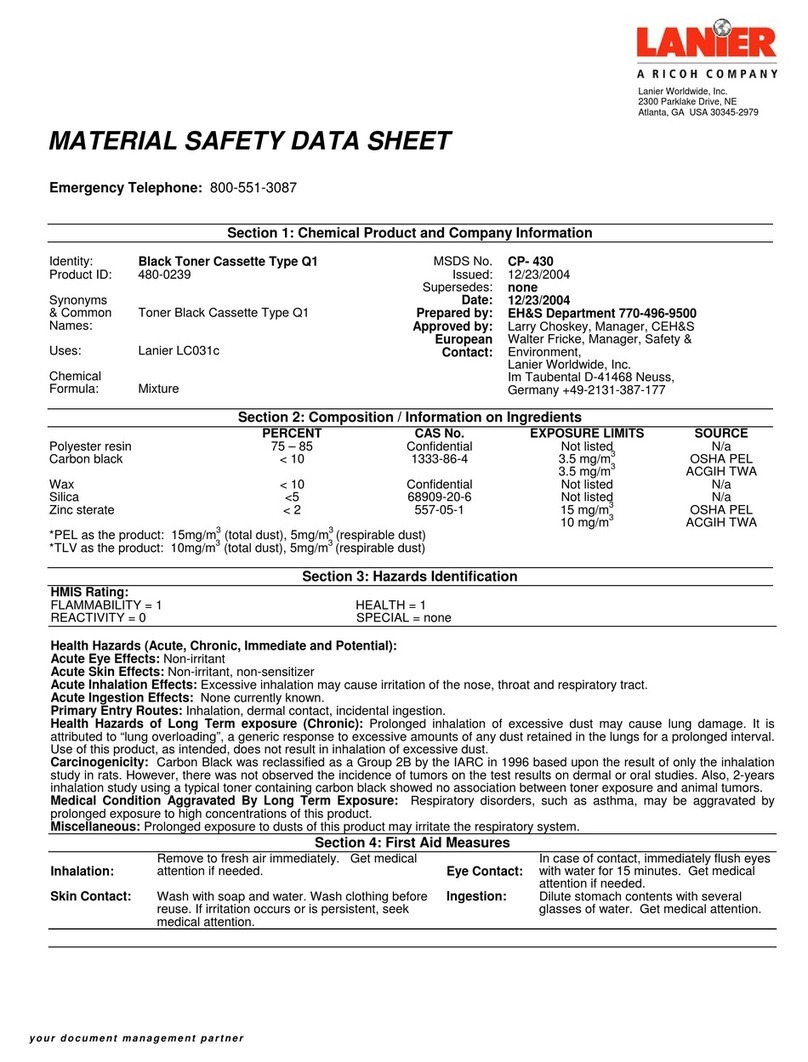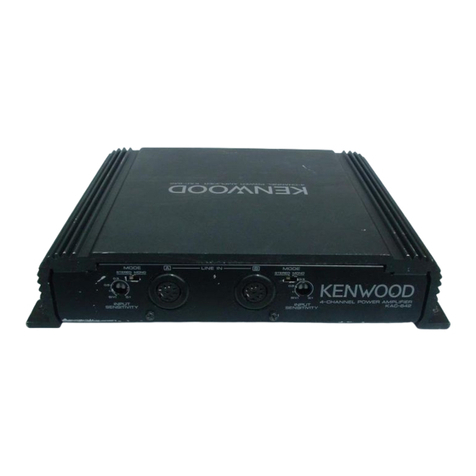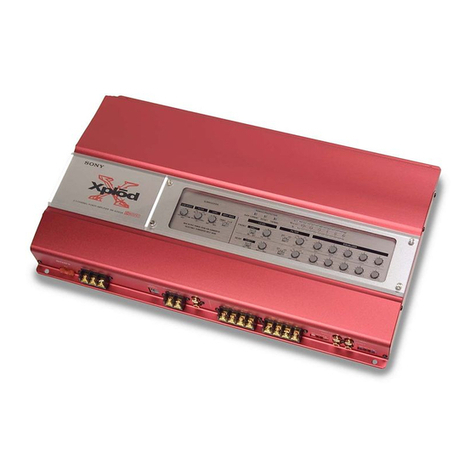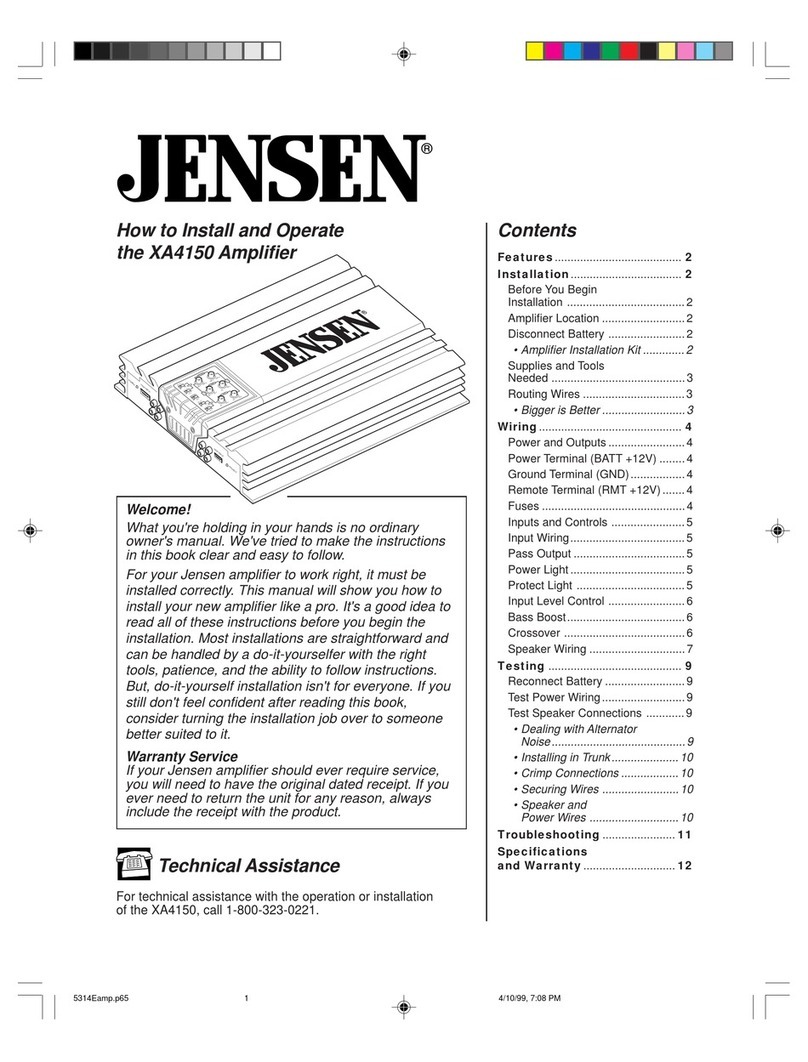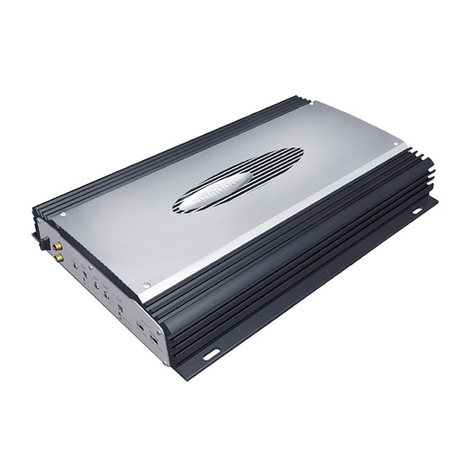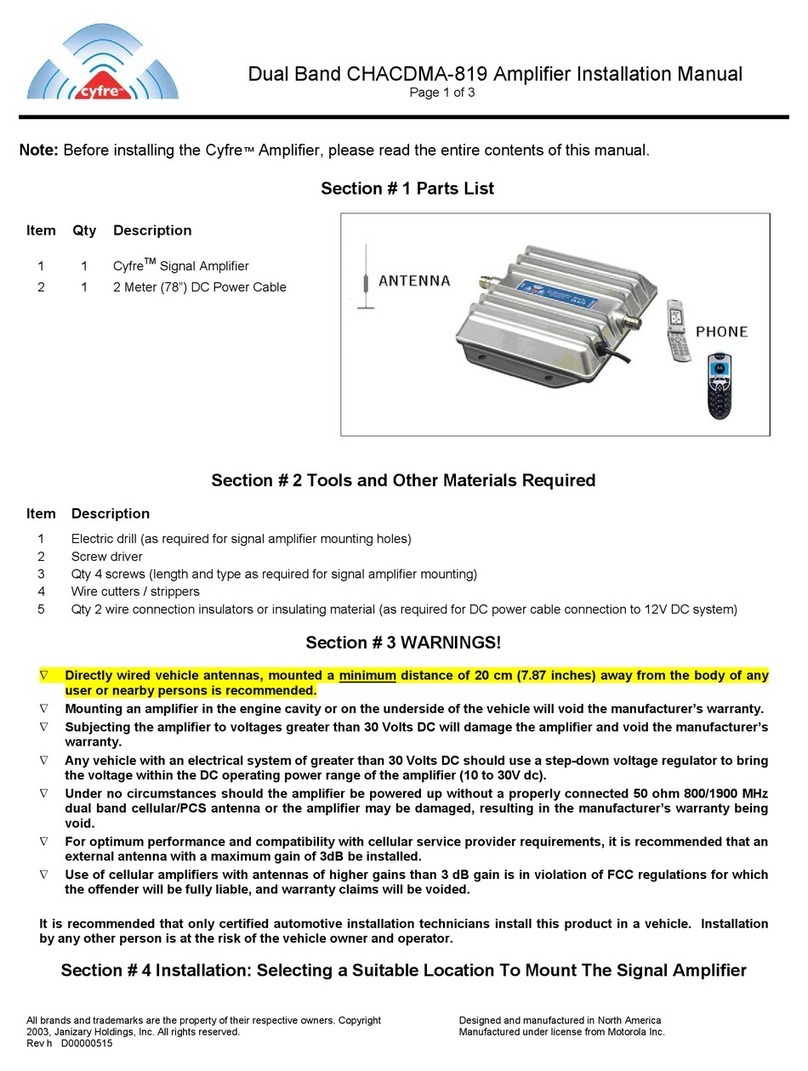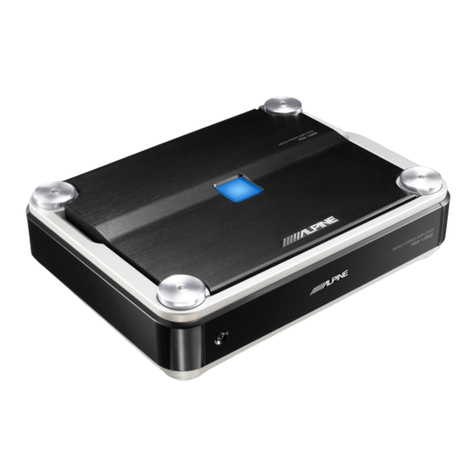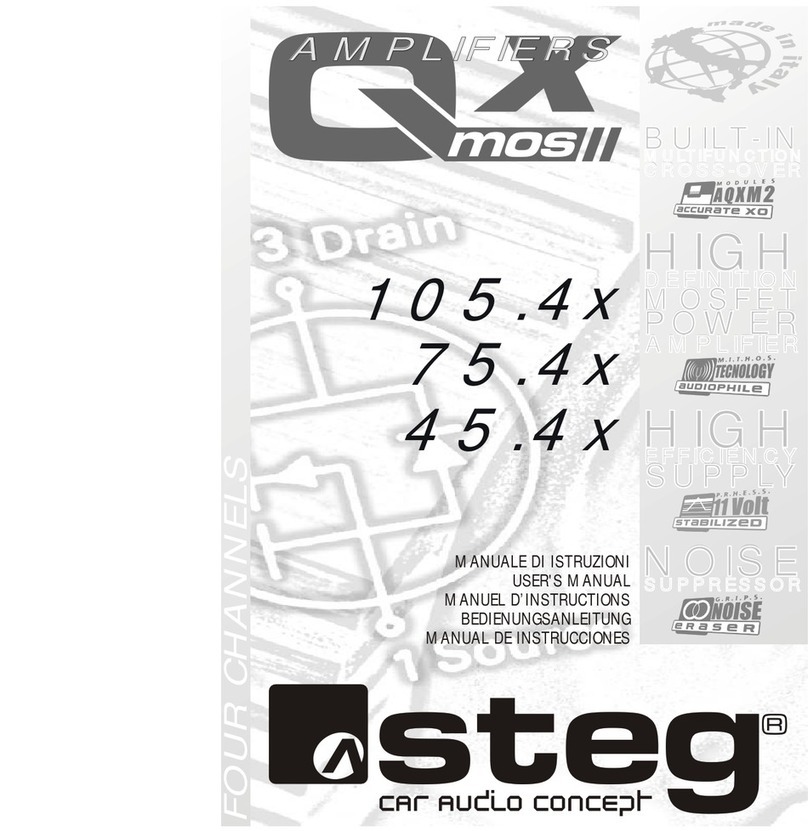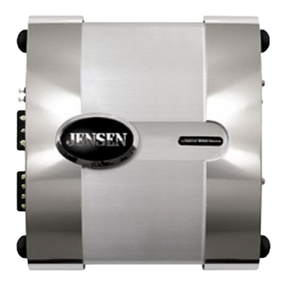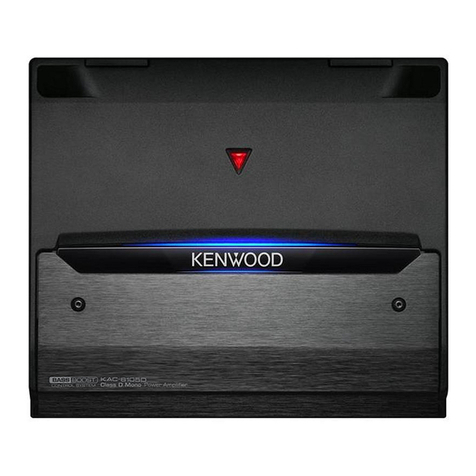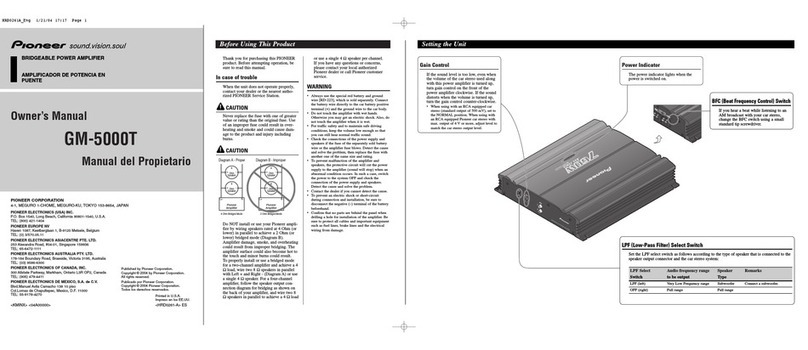4
DLS SOUND HANDBOOK - AMPLIFIER FACTS
DLS REFERENCE RA20 RA25 RA30 RA40 RA50
FILTER CONFIGURATION RA50
Ch. 1 & 2
High-pass 50 - 140 Hz*
Low-pass 250 - 700 Hz* (x 1 switch)
or 2,5 kHz - 7 kHz* (x 10 switch)
Ch. 3 & 4
High-pass 50 Hz - 140 Hz (x 1 switch)
or 250 Hz - 700 Hz (x 5 switch)
or 2,5 kHz - 7 kHz (x 50 switch)
Ch. 5
Low-pass 40 Hz - 125 Hz
Subsonic fixed 25 Hz*
*can be switched in/out
Number of channels 2 2 2 4 3 1 5 4
Power output in 4 ohm 2x45 W 2x85 W 2x150 W 4x85 W 2x85 W 1x500 W 4x60 W 4x40W
Power output in 2 ohm 2x80 W 2x145 W 2x270 W 4x145 W 2x100 W 1x870 W 4x100W 4x80 W
Power output in 1 ohm 2x120 W 2x220 W 2x425 W 2x220 W - 1x1200 W - -
Mono bridge mode 4 ohm 1x160 W 1x290 W 1x550 W 2x250 W - - - 2x165W
Mono bridge mode 2 ohm 1x240 W 1x450 W 1x870 W 2x400 W 2x220W
Mono bridge mode 1 ohm - - 1x1200 W -
Mono sub channel, nom. power 4 ohm
- - - - 1x300 W - 1x300 W -
Mono sub channel, nom. power 2 ohm
- - - - 1x500 W - 1x440 W -
Mono sub channel, nom. power 1 ohm 1x780 W 1x600 W
S / N ratio, A-weighted >100 dB >100 dB >100 dB >100 dB >100 dB >100 dB >100 dB >100 dB
Damping factor >200 >200 >200 >200 >200 >200 >200 >200
Input impedance >10 k >10 k >10 k >10 k >10 k >10 k >10 k >10 k
Input sensitivity 0,2-7V 0,2-7V 0,2-7V 0,2-7V 0,2-7V 0,2-7V 0,3-7V 0,5-5V
Filter highpass 20-200 Hz 20-200 Hz 20-200 Hz FRONT: LP: 50-125 Hz 50-150 Hz - FRONT: 80-400Hz / 1,6-8 kHz OFF/70/90 Hz
HP: 20-200 / 60-600 Hz REAR: 80-400 Hz
Filter lowpass OFF/70/90 Hz 50-125 Hz* 50-125 Hz* REAR:
LP: 45-200 / 90-400 Hz
40-90 Hz 50-125 Hz REAR: 0,3-4 kHz / 3-40 kHz 50-125 Hz
HP: 20-200 Hz SUB CH: 50-125 Hz
*can be switched in/out SUBSONIC: 25 Hz
Subsonic filter 25 Hz/18 dB - - - - yes yes no -
Dual DC-inputs - - yes yes - yes - -
Phase shift button 0 / 180° - - yes - - - - -
Phase shift control continuous - - - - 0-180 degrees 0-180 degrees 0-180 degrees -
Fan output terminal - - yes yes yes yes yes -
Remote sub level control - - - - yes yes yes -
POWER CONSUMPTION
Idle 0,5 A 0,6 A 1,1 A 1,5 A 0,5 A 0,6 A 1,1 A 0,7 A
Maximum 32 A 60 A 140 A 95 A 90 A 140 A 120 A 50 A
Dimensions (mm) 205x240x73 265x240x73 410x240x73 465x940x73 410x240x73 410x240x73 605x240x73 350x240x73
Dimensions (inch) 8,07x9,45x2,87 10,43x9,45x2,87 16,15x9,45x2,87 18,30x9,45x2,87 16,15x9,45x2,87 16,15x9,45x2,87 23,82x9,45x2,87 13,78x9,45x2,87
Weight 2,8 kg (6,17 lb) 3,7 kg (8,16 lb) 6,2 kg (13,67 lb) 6,6 kg (14,55 lb) 5,9 kg (13 lb) 6,2 kg (13,67 lb) 8,1 kg (17,86 lb) 4,8 kg (10,6 lb)
DLS ULTIMATE AMPLIFIERS A1 A2 A3 A4 A5 A6 A7 A8
Number of channels 2 2 3 4 5
Power output in 4 ohm 2 x 130 W 2 x 70 W 2 x 70 W + 1 x 265 W 4 x 75 W 4 x 70 W + 1 x 265 W
Power output in 2 ohm 2 x 220 W 2 x 110 W 2 x 100 W + 1 x 365 W 4 x 110 W 4 x 110 W + 1 x 365 W
Power output 4 ohm bridged 1 x 440 W 1 x 220 W - 2 x 220 W 2 x 220 W
Signal to noise ratio, A-weighted >100 dB >100 dB >100 dB >100 dB >100 dB
Damping factor >200 >200 >200 >200 >200
Frequency response +/- 0,5 dB 10 Hz - 50 kHz 10 Hz - 50 kHz 10 Hz - 50 kHz 10 Hz - 50 kHz 10 Hz - 50 kHz
Input impedance, low level >10 kohms >10 kohms >10 kohms >10 kohms >10 kohm
Input impedance, high level 330 ohms 330 ohms 330 ohms 330 ohms 330 ohm
High level input with auto start yes yes yes yes yes
Input sensitivity 0,2 - 7 V 0,2 - 7 V 0,2 - 7 V 0,2 - 7 V 0,5 - 8 V
Bass boost adjustable gain @ 40 Hz 0 - +18 dB - 0 - +18 dB 0 - +18 dB 0 - +18 dB
Phase shift 0 - 180 degrees continuously yes - yes yes yes
Remote bass level and phase shift - - yes, on sub ch. - yes, on sub ch.
Filter highpass / fixed subsonic filter 20 - 150 Hz* 20 - 150 Hz* 45 - 125 Hz* / 25 Hz* 20 - 150 Hz on all ch. see spec.
Filter lowpass 40 - 125 Hz* - 40 - 125 Hz 40 - 125 Hz* see spec.
*can be switched in/out
POWER CONSUMPTION
Idle 0,6 A 0,6 A 0,9 A 0,9 A 1,2A
Maximum 50 A 25A 70 A 50 A 90 A
Fuses 2 x 25 A 1 x 25 A 2 x 35 A 2 x 25 A 3 x 30A
Dimensions (mm) 59 x 359 x 245 59 x 247 x 245 59 x 385 x 245 59 x 359 x 245 59 x 479 x 245 mm
Dimensions (inch) 2,33 x 14,1 x 9,65 2,33 x 9,72 x 9,65 2,33 x 15,15 x 9,65 2,33 x 14,1 x 9,65 2,33 x 18,85 x 9,65
Weight 3,8 kg / 8,4 lb 2,6 kg / 5,7 lb 4,4 kg /9,3 lb 4 kg / 8,8 lb 5,5 kg / 12,1 lb
R.M.S. Power output at 13,8 Volts, 20 Hz - 20 kHz, max 0,1% THD, all channels driven:
Number of channels 1
Amplifier class AB
Power output in 4 ohm (0,1% THD) 1 x 300 W
Power output in 2 ohm (0,1% THD) 1 x 500 W
Power output in 1 ohm (0,1% THD) 1 x 820 W
All power ratings at 13,8 Volt
Signal to noise ratio, A-weighted >100 dB
Damping factor >200
Frequency response 10 Hz - 125 Hz
Input impedance >10 kohms
Input impedance, high level 330 ohms
High level input with auto start Yes
Input sensitivity 0,5 - 8 V
Phase control continuous 0 - 180 degrees
Bass boost adjustable gain 0 - +18 dB
Filter subsonic, 18 dB slope 25 Hz fixed
Filter lowpass 12 dB slope 40 - 125 Hz
*can be switched in/out
Power consumption, idle 1,5 A
Fuse 3 x 40 A
Dimensions (mm) 59 x 359 x 245
Dimensions (inch) 2,33 x 14,1 x 9,65
Weight 5,4 kg / 11,9 lb
DLS REFERENCE RA10
